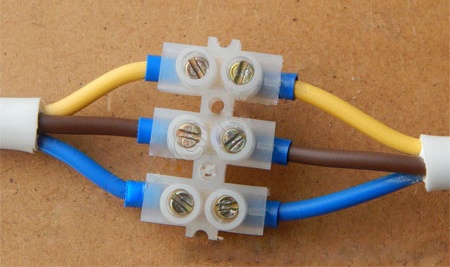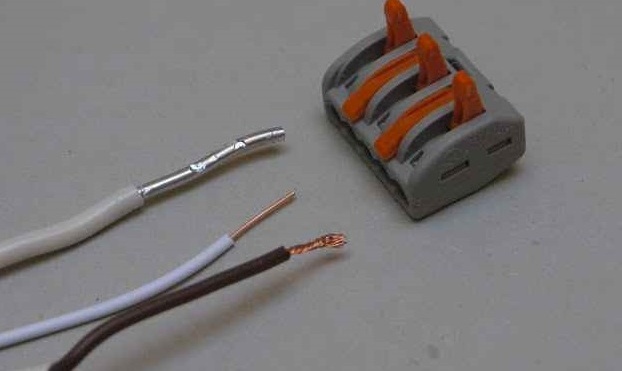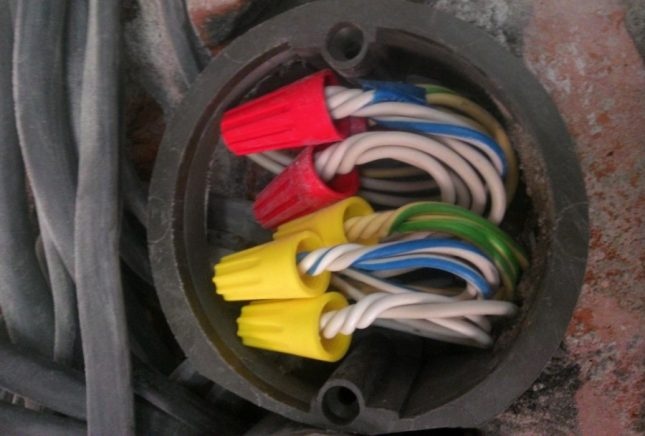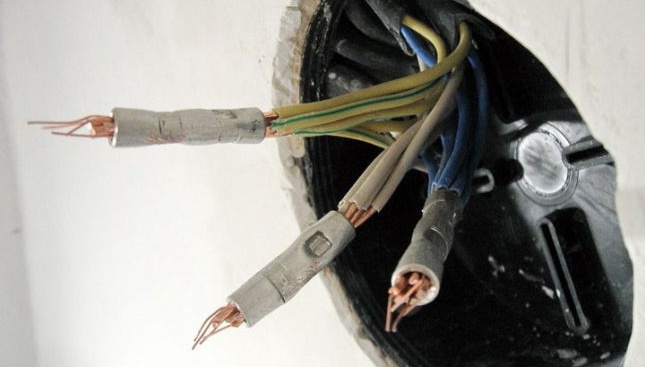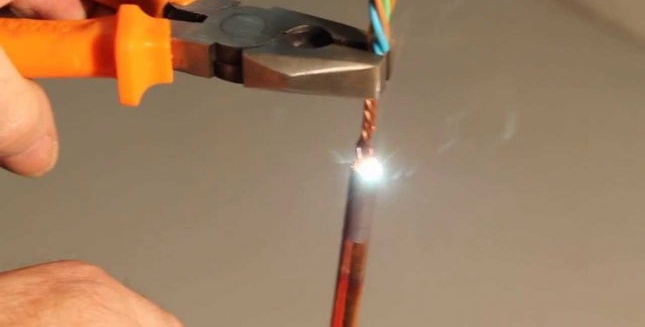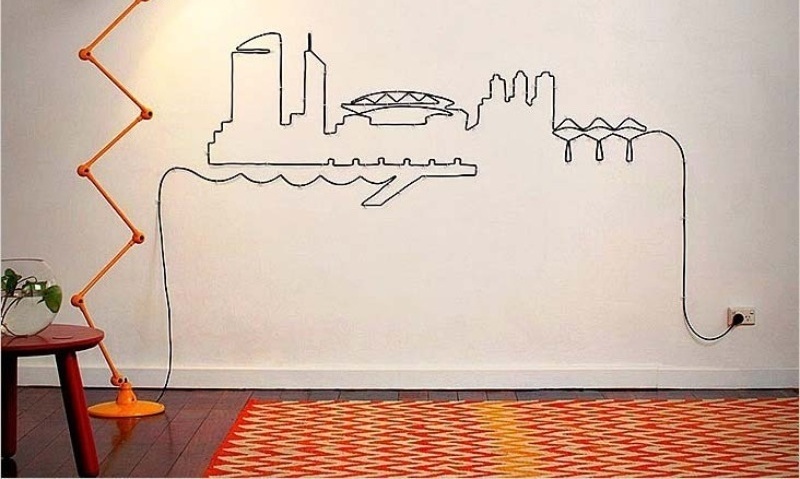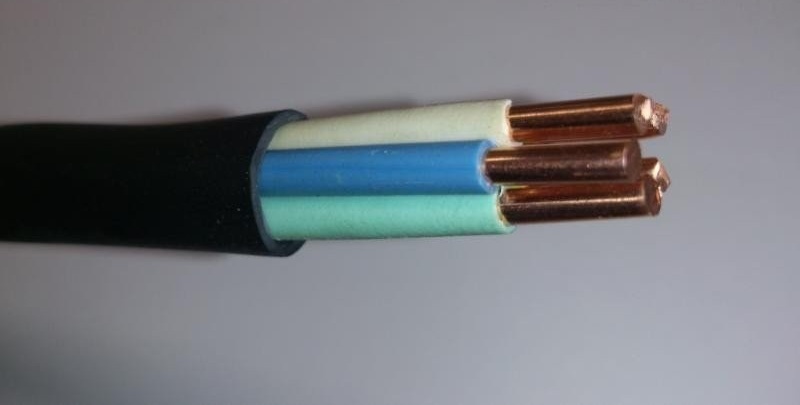Connection of stranded wire to single-core
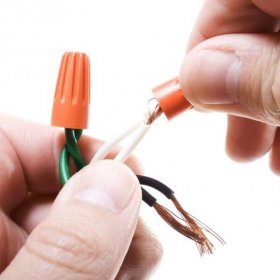
Wires and cables - structures represented by one or more insulated conductors from each other, enclosed in an insulating sheath. Before connecting a stranded wire to a single-core cable, it is very important to determine the physical and mechanical properties of the contact used, as well as all the installation features and operating rules of such electrical products.
Content
In what cases is it necessary to connect a stranded wire to a single-core cable
In accordance with the current PUE p. 2.1.21, several permissible methods of wire connection are presented separately, represented by screw or bolt clamps, as well as crimping, connection by welding or soldering.
The main scope:
- overhead power transmission lines;
- connections in high-power electrical networks;
- fixed connection;
- temporary connections;
- laying in the open air;
- assembly of connection groups in electrical panels for various purposes;
- standard living conditions.
Correctly made connection of a stranded wire with a single-core cable helps to ensure proper indicators of reliability and durability. If you comply with the connection requirements, you can get the highest quality connection that can be used in almost any field of modern electrification.
How to connect a stranded wire to a single core
The main installation task when making multi-core wire connections to a cable with one core is to obtain the most reliable and durable contact at the connection sections with minimizing the risk of overheating at the point of the electrical circuit. Despite the fact that connecting wires involves the use of several methods, to determine the optimal method, you need to evaluate all their advantages and disadvantages.
Terminal Block Method
Modern devices based on high-strength plastic with an installed brass sleeve and easily tightened double-sided screws are the best option for making independent connections.
Execution Technology:
- Stripping lived at the ends of the wires.
- Placing a pair of stripped ends inside the pads.
- Tightening the assembly screws with little physical effort.
The advantages of this method are its low cost, reliability of the connection and the possibility of using wires made of various materials.
Spring Terminal Method
Modern terminal devices are distinguished by the presence of a special convenient mechanism that allows you to accurately fix the wires without damage.
Execution technology involves:
- Stripping lived at the ends of the wires.
- Raise the lever or press the terminal spring.
- Placement of stripped insulation ends in the openings of the junction box.
- Release the spring or lower the terminal lever.
Disposable and reusable devices are now available in various price categories, which allows you to choose the best model depending on operating conditions. The advantages of this option also include the ability to connect stranded thin wires, compact dimensions and the presence of a convenient built-in indicator for monitoring the operation of the electrical network.
The terminals can also be used to connect aluminum wires. In more detail about it in our material:https://aquatech.tomathouse.com/en/ehlektrosnabzhenie/kak-soedinit-alyuminievyie-provoda.html.
Method with PPE caps
The use of connecting insulating clamps or caps with an internal spring holding the cores is relevant for use inside junction boxes of various types.
Step-by-step instruction:
- Preliminary stripping;
- Folding and aligning the cores with an insulating edge.
- Alignment of the length of the wires to the depth of the hole in the housing.
- Screwing the caps on the stripped wires in a clockwise direction until the built-in spring is activated.
The advantages of this compound are represented by an affordable price, minimizing the risk of fire, quick installation, a large selection of caps in size and color, as well as a very high quality of the connection. The method is not used when connecting copper wires to aluminum cables.
Crimping with sleeves
One of the most reliable and popular options to date. wire connections or cables. The method is simple enough to do it yourself, but requires the use of a special tool.
Stages of wire connection:
- Stripping the ends of the wires from the insulating layer.
- Docking of the stripped ends inside a special sleeve.
- Sufficiently tight crimp of the used sleeve with special press pliers.
- Insulation of crimped crimp.
The arrangement of cables can be on two sides of the sleeve or on one side. In the second case, it is very important to remember that the total cross-section of the connected cables must correspond to the diameter of the sleeve. Advantages of the compound are represented by high quality characteristics and quite affordable cost. Nevertheless, this option has some disadvantages, including a disposable sleeve material, some laboriousness and the need to purchase a special tool in the form of a pipe cutter and press tongs.
You may also find useful material about choosing wires for wiring:https://aquatech.tomathouse.com/en/ehlektrosnabzhenie/kakoy-provod-ispolzovat-dlya-provodki-v-dome.html.
Soldering or welding method
Experienced electricians most often use soldering or welding to connect several cores inside a junction box. The method is not too complicated to carry out independently, but it will require certain skills and the presence of a household soldering iron or special welding equipment.
Execution technology involves:
- Bare ends of wires.
- Twisting prepared sections.
- Connection of bare veins by soldering or welding.
- Insulate the area using insulating tape, heat shrink tubing or cambric.
The main advantages of this method are represented by reliable and very strong wire bonding, but it should be remembered that a special tool is required for this connection. The complexity of the soldering process to obtain an integral connection and restrictions in accordance with the terms of use stated in the clauses of the EMP should also be taken into account.
Security measures
The category of non-professional compounds includes the method of twisting stranded wires with single-core. This option of cable connection by general rules and established safety measures is not provided, therefore this connection, as a rule, is always rejected by the specialists of the selection committee, as a result of which the facilities are not accepted for operation.
Most often, such twisting inside a special box is used as an intermediate operation, preceding soldering or welding, as well as crimping all joints, or in emergency cases, in the absence of the ability to make a professional connection.
Security measures provided:
- accurate removal of insulation at the connection areas;
- degreasing of exposed wire with acetone;
- thorough cleaning of fat-free area with sandpaper;
- restoration of wire insulation at the connection site.
In practice, several connection options may be used for safety reasons, including:
- simple parallel twisting. The most common and simplest option for independent execution is a connection with a fairly good contact quality, but weakening by vibration or mechanical stress;
- the method of "winding", used if necessary, to carry out the branching of wires from the central highway.
- bandage twisting for connecting two or more wires with an additional conductor of the same material. The option promotes mechanical tensile strength at the joint.
The most successful and most reliable way to temporarily connect in compliance with all safety measures is still considered the option of simple wrapping with subsequent clamping. It is important to remember that the method of twisting the conductors is considered unsafe if, after connecting, a good, high-quality insulation of the contacting sections is not used.
Knowledge of the principles of connecting wires is needed when assembling or repairing various electrical appliances and devices, for example, dimmers:https://aquatech.tomathouse.com/en/ehlektrosnabzhenie/kak-podklyuchit-dimmer.html.
The bonding of single-core wires with multicore cables does not differ in any special conditions, so almost any method of connection can be used. Nevertheless, each option has some advantages and disadvantages that must be taken into account in order to choose the best method of attachment.
